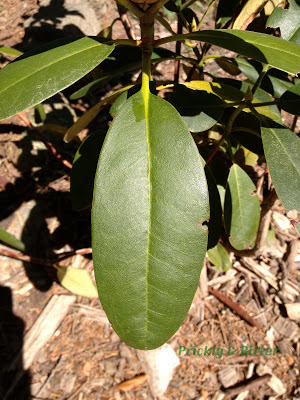Tuesday, June 4, 2013
Allz you ever wanted to know about Rhododendrons
Species name: Rhododendron sp. (perhaps a cultivar or variety of R. wardii but I'm not positive)
Common name: rhododendron
Location: Sandra's garden
Rhododendrons are really gaining popularity in North America as garden plants, especially those species that are native to this continent. Most gardeners aren't actually aware that we have many native North American species of rhododendron, since the most widely available and easiest to grow are those native to China (like this one probably is), Japan, Korea and Taiwan. Rhododendrons prefer acidic soil which is most commonly found under very old coniferous trees. So if you have some pruned firs, spruces or pines (so that the lowest branches are several feet off the ground and the base of the tree receives a fair bit of sunlight) and want to plant something under them, rhododendrons would be a good bet! Just make sure they will receive enough sunlight; they do best in full sun. Make sure you take care in paying attention to what species you're planting and where you live; various species of rhododendrons can be highly invasive in locations where they are not native.
If you grow your own honey, which is also gaining in popularity with gardeners with large yards since bee populations are on the decline, it is strongly suggested that you do so only when your bees wouldn't have ready access to rhododendrons (and other species in the same genus that we call azaleas because the flowers only have five anthers instead of the usual ten; you can read my previous blog about azaleas HERE). The pollen and nectar of rhododendons contains a toxin called grayanotoxin, which can cause hallucinogenic and laxative effects. Not exactly the kind of thing you're expecting when you consume honey! Horses have an even more extreme reaction to grayanotoxin: it can cause seizures and even death. Thankfully for horses, they usually avoid rhododendons based on the smell alone and would rather look for something else to eat. Cats and dogs also have adverse effects to rhododendrons, but the effect is much more pronounced in dogs than in cats (are cats smarter for staying away from the plant more often? Perhaps. Is this my bias for what pet I prefer more? Perhaps...). Dogs like to chew on sticks, so if you prune this plant and leave the sticks laying around your beloved pet might be in for a surprise. Symptoms include digestive issues, heart palpitations, heart attack, and liver failure. Eventually these symptoms will lead to death if the animal is left untreated. Supervise your pets around your landscape plants!
Rhododendron species are very important to different cultures around the world. For example, different species of rhododendron are the national flower of Nepal, the state flower of both Indian-administered and Pakistan-controlled Kashmir, the state tree of Sikkim and Uttarakhand in India, and the state flower of West Virginia, Pennsylvania, and Washington in the United States. Not bad for a plant!
Subscribe to:
Post Comments (Atom)





No comments:
Post a Comment